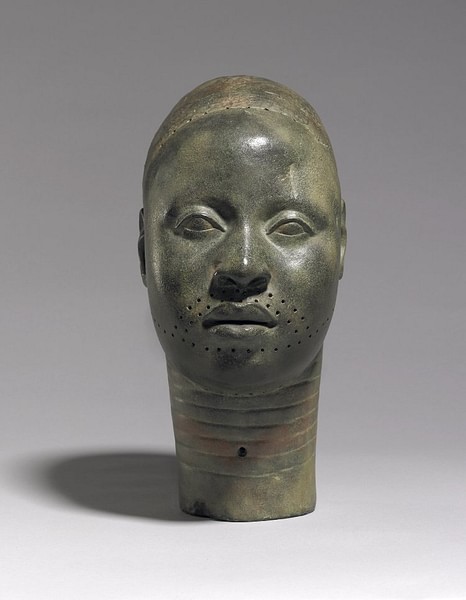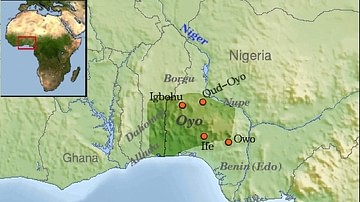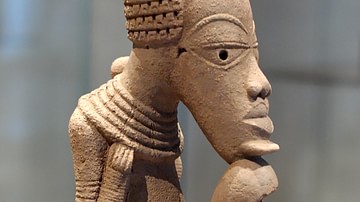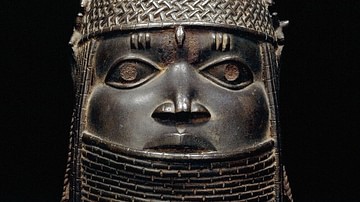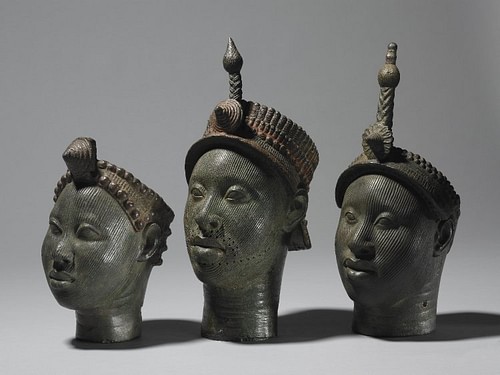
Ife (aka Ile-Ife) was an ancient African city which flourished between the 11th and 15th century CE in what is today Nigeria in West Africa. Ife was the capital and principal religious centre of the Yoruba kingdom of Ife, which prospered thanks to trade connections with other West African kingdoms. Ife is particularly famous today for the magnificent metal sculptures its artists produced which include serene-looking human heads so masterfully crafted that Europeans once wrongly considered them the work of another civilization.
Located in today's Nigeria along the Guinea coast of southern West Africa, Ife controlled the rainforest to the west of the River Niger delta. Ife was founded c. 500 CE by the Yoruba people - a Kwa-speaking people of southwest Nigeria and Benin - but did not flourish until the early part of the 2nd millennium CE. Ife culture may have been influenced or somehow connected to the kingdom of Igbo-Ukwu, which peaked in the 9th century CE on the other side of the River Niger, but details of this period of history in southern West Africa are lacking. The kingdom of Ife had disappeared by the 16th century CE for reasons which are unknown.
Place of Creation
The Yoruba considered the site of Ife the exact place of creation, that is where the gods descended from heaven and created the world as we know it. There are several versions of the creation myth and details vary. The creator god Oduduwa separated earth from water. Living creatures were made by Obatala. The first humans were sent forth to rule over twelve cities and so became their first kings and queens. From these figures all subsequent rulers claimed descendance. Specifically at Ife, the first divine ruler was Oni, whose name means 'king'.
Archaeological excavations have revealed that the occupation of Ife was interrupted several times, and this may explain why little is known of its early cultural practices as traditions were not passed on orally to subsequent generations. The king was likely also the head of Ife's religion - a blend of animism and fetish and ancestor worship. Sacrifices and offerings were made to both gods and ancestors. There was (and still is amongst the Yoruba today) a belief that a person's character (iwa) reflected their inner energy (Ase) and that this energy is present in all things natural and divine. The energy was thought to reside primarily within a person's head, which may explain why the art of ancient Ife typically concentrates on this part of the body. Further, because the energy of powerful people like chiefs can be dangerous, it is necessary that their mouths or even the whole face be covered with a veil - another feature commonly represented in Ife art. Ase is often represented as a cone, yet another symbol frequently seen in the headdresses of human representations in Ife sculpture.

Trade
Very little is known about the state apparatus of Ife and how it controlled its territory. Even information on the economy of Ife is sparse. It is likely that Ife, and the whole area of the West African rainforest in general, prospered thanks to iron-smelting technology which could produce iron tools like the hoe and so, in turn, bring forth plentiful harvests of food such as okra, yams, dates, palm oil, and fish. Goods which could be traded with kingdoms to the north included kola nuts, pepper, gold, and ivory. Slaves were also sent northwards and so Ife was indirectly connected to the camel caravan trade routes that crossed the Sahara and reached such cities as Tripoli on the Mediterranean coast. Goods exchanged for those provided by Ife would have been principally salt from the Sahara and luxury goods for the Ife elite who controlled the trade. The luxury items would have included swords, copper, brass, jewellery, perfumes, and horses.
Ife Architecture
By the beginning of the 11th century CE, Ife had grown to become a large walled city with several large stone buildings and including a palace, workshops, and shrines. Some of the city's streets were paved with terracotta tiles to make them more resistant to rain. Similarly, many courtyards were paved with small pieces of pottery and quartz pebbles to create geometrical designs. Some courtyards have altars consisting of a low semicircular structure with the neck of a pottery vessel placed within it. The majority of housing, unfortunately, was made using clay, and these have long since perished, but a clue to their original decorative appearance is finds of many small pottery discs which were stuck into them to create a mosaic effect.
Ife Head Sculptures
The metal sculptures of naturalistic and life-size human heads for which Ife is today most famous are so masterfully executed that when Europeans discovered them they could not believe that ancient black Africans had made such masterpieces. The heads were made from the 11th to 15th century CE according to chemical analysis and cast using the lost-wax process. Twelve heads were found all together in a royal compound at Ife in 1938 CE and several more have been discovered since including a pure copper mask.
The head sculptures were cast in brass and sometimes also made from pottery. The human heads are all unique but their precise purpose is not known. They may represent rulers, gods, revered ancestors or have been used for some religious purpose. Many heads have vertical lines down the face and these may represent the ritual scars which marked an individual's passage from childhood to adulthood. The problem with this theory is scarification was not widely practised amongst the Yoruba people. Alternatively, the scars may have differentiated more local groups within the wider Yoruba population, reflected the practice of wearing temporary facial markings for rituals, perhaps represented the shadows created by the veils rulers commonly wore or, most simply, have been a form of aesthetic decoration. The heads have another curious feature which is a series of punched holes around the lips and jawline, possibly for the attachment of beards or veils of glass beads. These veils are still worn today in the region on special occasions and their ceremonial significance is here summarised by the African specialist P. Garlake:
The life-size brass heads of Ife are powerful expressions of serenity born of divine authority. This was the most important quality of any ruler…The veils are intended to make extraordinary potency of a ruler's words less likely to cause fear and hurt. Mystery masks majesty. (117)
One exceptional piece of Ife sculpture which is not a head is a bronze figure of a standing chief who wears a kilt-like garment, many necklaces - including one with a double bow insignia, anklets, and a beaded hat with a high frontal decoration. The figure is holding in one hand a forest buffalo horn, likely used as a container of medicine, and in the other hand a short staff. Dating to the 14th century CE, the figure now resides in the archaeological museum of Lagos, Nigeria.
Other Arts
Much older than the striking brass heads of Ife are the several granite stelae discovered at the site. With little decoration, these are sometimes inlaid with iron nails. Pottery vessels made at Ife were often decorated with geometrical relief designs around the neck, and a number of large vessels were discovered near the royal palace of Ife, which had lids with sculpted animal heads (e.g. a ram, elephant, and antelope) on them but placed with the heads inside the vessel. There are also pottery sculptures of human and animal figures. The latter are mostly hollow and made of composite pieces. One group of these pottery sculptures excavated from a shrine at Ife all show humans with physical deformities, signs of disease or with expressions of suffering. Curiously, these and other similar figures seem to have been buried as if they were the remains of living people.
Another object produced in some numbers was sculpted brass torques, perhaps originally placed around the brass heads described above. These intricately carved pieces typically depict scenes of human sacrifice and rituals, perhaps indicating the power of the rulers who wore them if the brass heads are taken as being representations of Yoruba chiefs. Glass beads were produced or at least imported and then reworked in great quantities. Another impressive artistic output was the manufacture of ceremonial stools from single blocks of quartz. This mineral is so hard it cannot be sculpted but only ground in a long and laborious process that indicates Ife craftworkers had almost boundless ambition in the materials they worked with.
Legacy & Later History
The sculptures of Ife very likely influenced those produced in the kingdom of Benin (12th to 15th century CE), also in modern Nigeria and also largely composed of the Yoruba people. Certainly, in Benin oral traditions, it was the king of Ife who sent a master craftsman to Benin to spread his sculptural skills. There are also many points of similarity in the art of the two cultures such as a frequent representation of snakes. Although the kingdom of Ife ceased to exist from the late 15th century CE - exactly why it declined is not known - Ife still exists today as a small out of the way town which continues to hold a position of religious importance as a site of shrines and sacred groves and the home of various societies of believers who still worship traditional gods.
